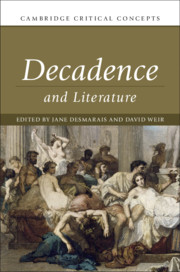Book contents
- Decadence and Literature
- Cambridge Critical Concepts
- Decadence and Literature
- Copyright page
- Dedication
- Contents
- Figures
- Contributors
- Acknowledgements
- Introduction
- Part I Origins
- Part II Developments
- Chapter 8 Decadence and the Visual Arts
- Chapter 9 Decadence and Music
- Chapter 10 Decadence, Parody, and New Women’s Writing
- Chapter 11 The Philosophy of Decadence
- Chapter 12 The Sexual Psychology of Decadence
- Chapter 13 The Theology of Decadence
- Chapter 14 The Science of Decadence
- Chapter 15 The Sociology of Decadence
- Part III Applications
- Select Bibliography
- Index
- References
Chapter 12 - The Sexual Psychology of Decadence
from Part II - Developments
Published online by Cambridge University Press: 12 August 2019
- Decadence and Literature
- Cambridge Critical Concepts
- Decadence and Literature
- Copyright page
- Dedication
- Contents
- Figures
- Contributors
- Acknowledgements
- Introduction
- Part I Origins
- Part II Developments
- Chapter 8 Decadence and the Visual Arts
- Chapter 9 Decadence and Music
- Chapter 10 Decadence, Parody, and New Women’s Writing
- Chapter 11 The Philosophy of Decadence
- Chapter 12 The Sexual Psychology of Decadence
- Chapter 13 The Theology of Decadence
- Chapter 14 The Science of Decadence
- Chapter 15 The Sociology of Decadence
- Part III Applications
- Select Bibliography
- Index
- References
Summary
Decadents were the heirs of the Enlightenment libertines who took the liberty of exploring ethics in a world in which morality was no longer handed down by God. In such a secular environment, sexual freedom was an offshoot of political and moral philosophy; free love and free thinking went together. The Marquis de Sade embodied the libertine for the eighteenth century, but the fin de siècle expanded the repertoire to admit not just sadism, but also masochism, bestiality, homosexuality and lesbianism, heterosexuality (the word was first coined to name a perversion), voyeurism, fetishism, and all manner of paraphilias (frottage, paedophilia, priapism, transvestism, and vampirism, to name but a few). These topics were mostly explored through imaginative writing (novels, plays, poetry) rather than in lived experience ? what philosophers might call ‘thought experiments’ ? but such bold discussion of taboo subjects came to characterize decadent literature in works by Swinburne, Huysmans, Rachilde, Wilde, and others.
- Type
- Chapter
- Information
- Decadence and Literature , pp. 200 - 215Publisher: Cambridge University PressPrint publication year: 2019

